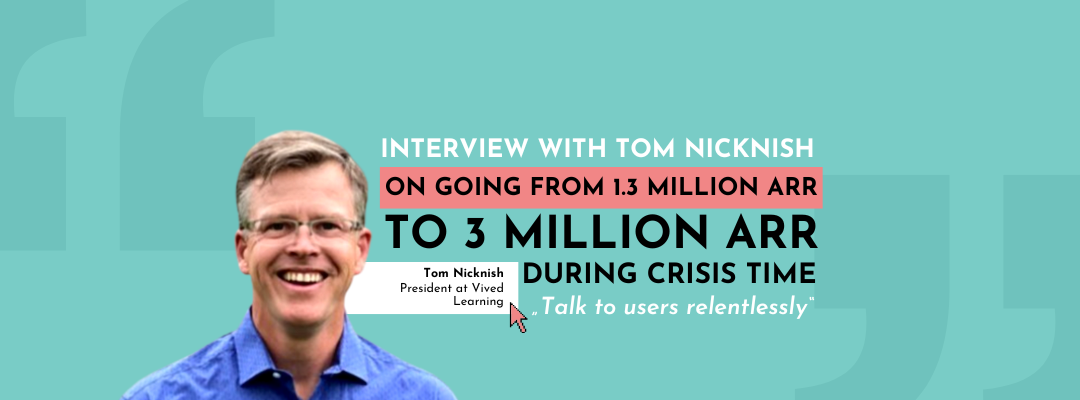Our partnerships come from tradeshow marketing and LinkedIn outreach.
We’ve been speaking with founders of successful startups about how they introduced their products to the market in order to inspire people who want to start their own businesses.
In this interview, we have Tom Nicknish, president at Vived Learning.
Tom has been with Vived Learning, an Iowa-based edtech company that has impacted more than 2 million students worldwide and students in 7 of the top 10 districts in the United States, for 10 years. As president of Vived Learning, he works to grow the company’s library of educational content, make its products easier to use, and make new partnerships in the US and around the world.
Before joining Vived Learning, Tom worked in sales, service, and marketing for a number of successful companies. These companies included medical devices, technology startups, Dimension X (which Microsoft bought in 1997), Ingenio.com (which AT&T bought in 2005), Microsoft, ADP, and Stryker. He holds a B.A. in Computer Graphics from Dominican University (IL). Tom currently resides in Iowa City with his two kids, three cats, and a dog.
Vived Learning is working with creators to make new experiences that will help education solution providers make more interesting content for teaching and learning.
They leverage their content editor to assist education solutions providers, like Cengage Learning, McGraw-Hill, Elsevier, and zSpace, with creating content that engages students and gets them thinking in new ways about general science, anatomy, chemistry, and carpentry.
What is the backstory of Vived Learning? How did you get from an idea to a business?
In 2007, there was a demand for human cadavers that could not be met due to cultural reasons and excessive costs. We developed Cyber-Anatomy Med, a virtual cadaver of the human body, to offer a more extensive and cheaper option to schools, colleges, and universities while working in partnership with the Elsevier Netter Team.
In 2010, PETA saw our human anatomy offering and asked if we could create a virtual frog to provide an alternative for frog dissections.
In 2016, we partnered with Cengage Gale to provide Anatomy, General Science, and a new solution for Chemistry online to target STEM users.
In 2020, we began working in the CTE space with our Vived Carpentry solution.
How did you get your first customers?
Our validation steps come from talking to students, teachers, and educational solutions providers at tradeshows and other events to verify our next steps, and then we create a simple MVP and continue to iterate to develop a product or offering.
This validation process encouraged us to consider a new medium for interactive learning. Based on feedback and seeing where the market is going, we started development of our new platform in 2021 to enable others to create engaging learning experiences.
You made a big turnaround in 2020. During the COVID crisis, you went from 1.3 million ARR to 3 million ARR now. Can you go into more detail and tell us the key factors contributing to this growth?
Our STEM resources (3-D models) started to gain attention when schools started to provide more resources online. Some big adoptions in the states of California and Texas really catapulted our growth, as did large adoptions in the largest school districts like Broward County, Clark County, Chicago Public Schools, and others.
What marketing strategies have been successful for Vived Learning so far?
Our partnerships come from tradeshow marketing and LinkedIn outreach.
How did you get your first customers?
Our partnership with the Elsevier Netter team back in 2007 enabled us to get our solutions in front of students inside the cover of the book using scratch-off codes. This offering continues to this day.
What acquisition channels worked for reaching new users/customers?
Outreach to expand our channels comes from our partners. zSpace, Cengage Gale, Cengage Learning, McGraw-Hill, Elsevier Netter, Safari Montage, and most recently Bluum. These organizations position, market, and sell our solutions to schools.
I notice from your website that you collaborate with over 3000 schools, which is very impressive. Can you go into more detail regarding forging partnerships with other businesses and what elements contributed to your success in doing so?
Our partners come to us to get engaging supplemental content that captures the attention of students for STEM and now CTE subjects. We provide the sizzle and they enrich the content with curriculum resources.
What do you consider your biggest win so far with Vived Learning?
Landing the State of California and Texas adoptions have been the biggest deals for us. These deals were instant validation for our offerings.
What is your advice to founders who are just starting?
Talk to users relentlessly. Develop your MVP only once you have a solid understanding of what users want.
Join the conversation
If you’re a startup founder with a unique story to tell, we’d love to hear from you!
Contact us to be featured in the upcoming interviews.


